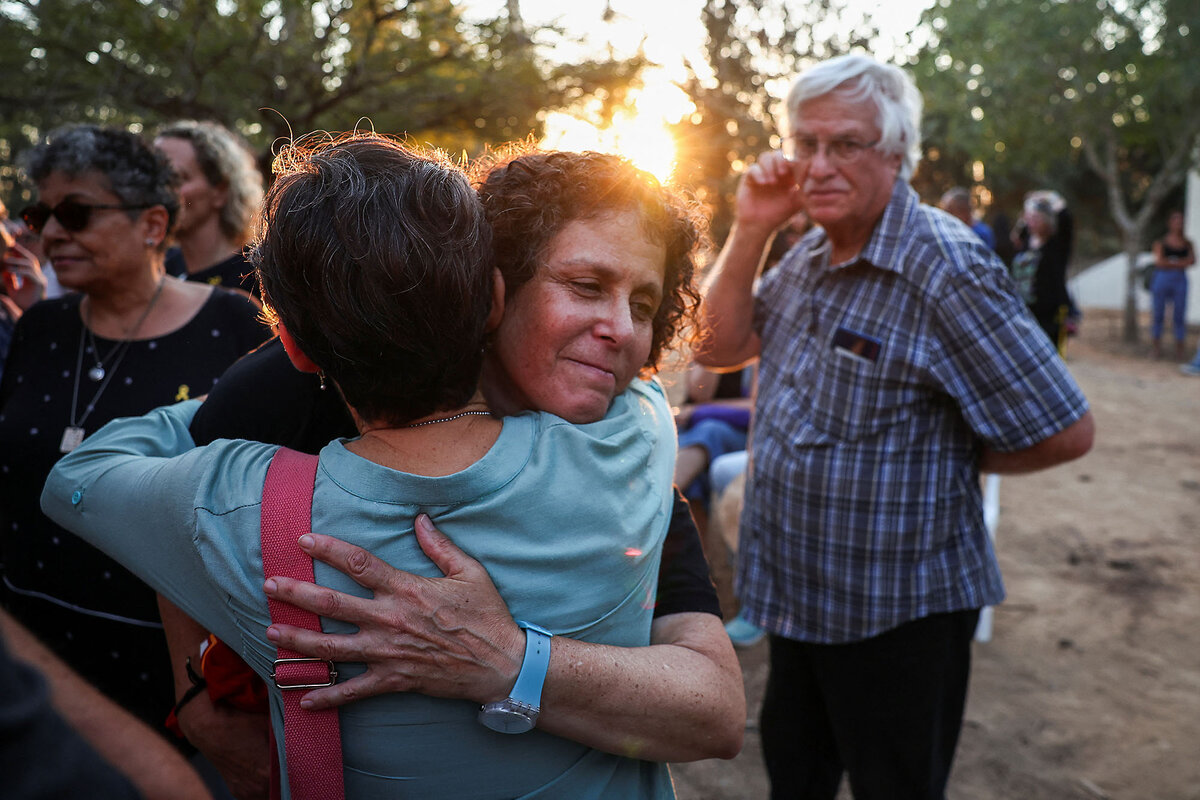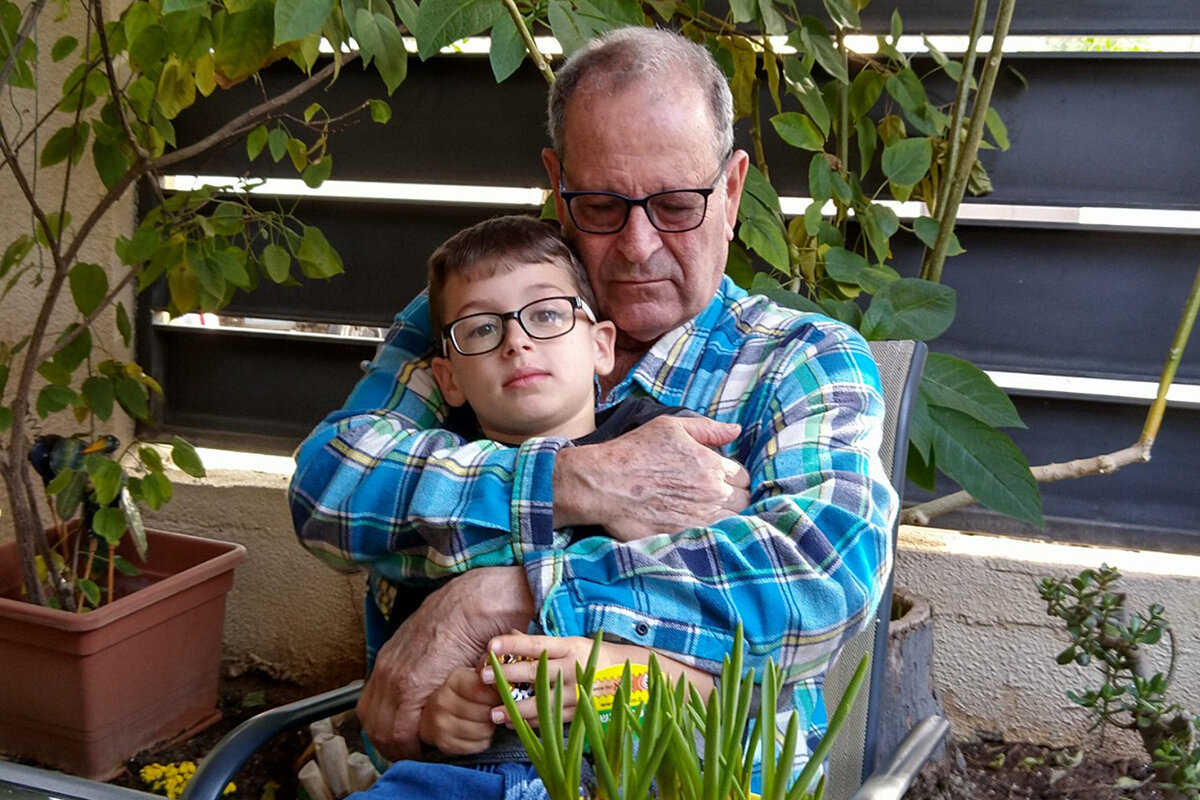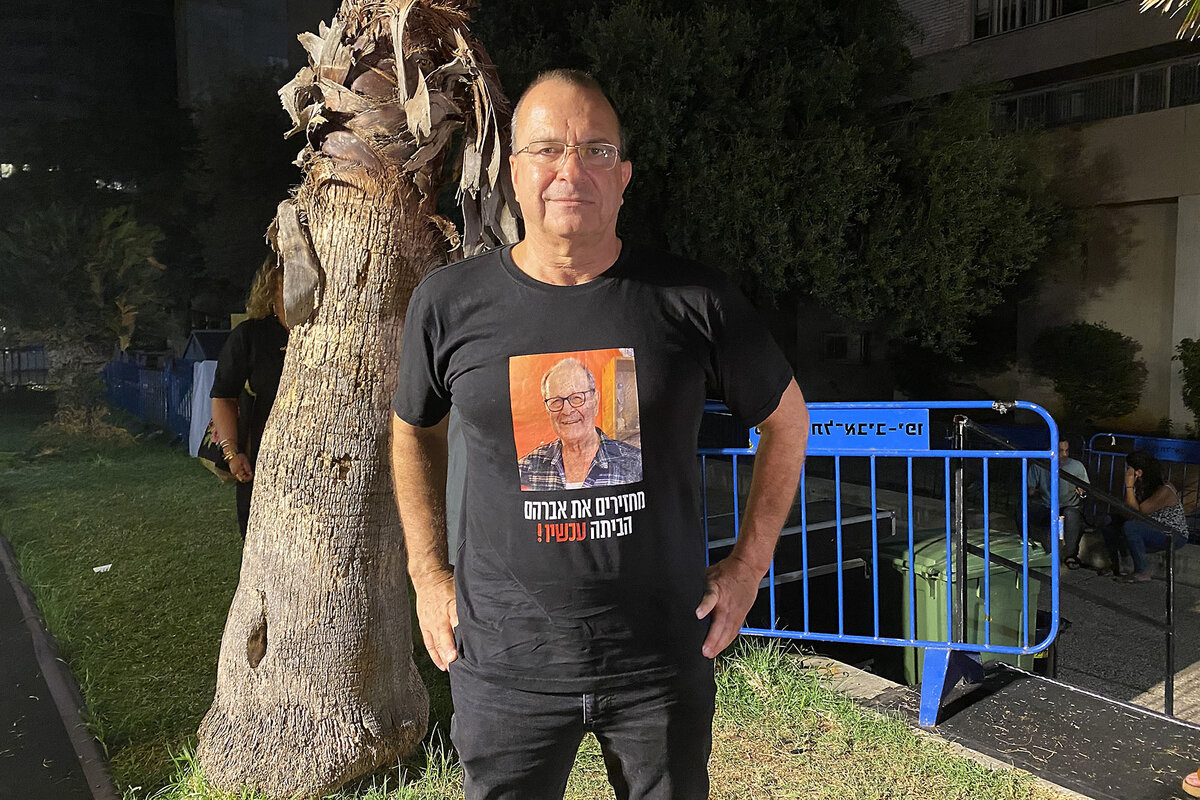Only the hostage’s body came home. ‘Our country did not save him,’ family says.
Loading...
| TEL AVIV, Israel
Just days after the Israeli army extracted the bodies of six hostages from a Hamas tunnel in Gaza and brought them home for burial, the feelings of frustration and anger were palpable at the weekly rally of hostage families in Tel Aviv Saturday night.
Cries for the government to strike a deal to save the remaining hostages still alive seemed louder. The words “abandoned” and “betrayal” abounded, as did calls for the replacement of Prime Minister Benjamin Netanyahu, who has failed his people and the hostages, said the speakers addressing the restless gathering.
After 10 1/2 months of war, more than 100 hostages are still in Gaza, many of them already known to be dead. As a result, despair has given way to anger at the Hostages Square demonstrations in Tel Aviv.
Why We Wrote This
A story focused onFor months, every Saturday night, the families of hostages held in Gaza have gathered to demand that Israel secure their loved ones’ release. Last week, six bodies were recovered, fueling the families’ sense that they’ve been abandoned by the government.
“The same state leadership that failed to protect them in their homes [on Oct. 7] ... neglected them repeatedly, stubbornly missing every opportunity to bring them back in a deal,” Eyal Mor, the nephew of deceased hostage Abraham Munder, told the crowd.
Hamas militants took Mr. Munder hostage from Kibbutz Nir Oz, near the Gaza border. His body was retrieved last week in an overnight Israel Defense Forces (IDF) operation from a tunnel in Khan Yunis, along with the bodies of five others: Alex Dancyg, Chaim Peri, Yagev Buchshtab, Yoram Metzger, and Nadav Popplewell.
According to released hostages’ testimonies and a Hamas video, they were all alive when taken captive. Autopsy results released by Israel indicated that all six were shot while in Hamas captivity.
“We’ll never know what went through the minds of Chaim, Alex, Yoram, Nadav, Yagev, and Abraham during those months of physical and mental torture, but I believe any guess containing the words ‘abandonment’ or ‘betrayal’ would hit the mark,” Mr. Mor told the square thronged with people.
“All the hostages whose bodies were recovered this week could all have been saved alive,” said Gil Dickmann, cousin of Carmel Gat, who is still a hostage.
Family’s frustration
In an interview with the Monitor on the sidelines of the rally, Mr. Mor recounts his family’s emotional ordeal.
“What is frustrating, very frustrating, to us is the fact that, according to the army, he was still alive in March,” he says. “This means he had survived for five months, in all the terrible conditions.
“He was nearly 80. ... He was not a healthy person to begin with when he was kidnapped, but still, with these terrible conditions of no fresh air and no sunlight and disconnection from the external world and little food, little water ... still [he] survived for five months.”
Mr. Munder was kidnapped from his kibbutz home along with his wife, Ruth; his daughter, Keren; and his grandson, Ohad, then 8 years old. Keren and Ohad were visiting from Kfar Saba, in central Israel, to celebrate the Jewish festival of Simchat Torah together with the elder Munders and Roy Munder, Keren’s brother, who also lived on Nir Oz.
When the rocket alarms sounded early that morning, the elder Munders, Keren, and Ohad made their way to their home’s safe room. Soon they heard gunshots and shouts in Arabic, and then noise of destruction and shouting within their home.
Mr. Munder, who used a cane, quickly rose from his chair and seized the handle of the safe room’s door, in a desperate effort to stop the intruders.
“Keren said she saw her 79-year-old ... physically weak father fighting for the door handle, when the terrorists tried to open it,” recounts Mr. Mor. “He was fighting, fighting for the life of his family.”
When the attackers prevailed, they knocked Mr. Munder onto his knees, and rounded up and kidnapped his wife, daughter, and grandson. Mr. Munder was hauled into Gaza separately about half an hour later, by motorbike, Mr. Mor says.
Meanwhile, Roy was killed 500 yards from his parents’ home, in the yard in front of his burning house. About a quarter of the community’s 400 residents were killed or taken hostage Oct. 7.
“Our hope ... collapsed”
In November, Ruth, Keren, and Ohad were released in a prisoner exchange. While in Gaza, they heard on the radio that Roy had been killed. Only upon their release did they learn that Abraham was still alive and a hostage.
Now, they know he is dead.
“We have mixed emotions,” says Mr. Mor. “On one hand, our hope ... collapsed. We realize he is no longer with us. On the other hand, the IDF managed to bring him … to be buried in the fields, the land of the kibbutz he loved so much.”
At the funeral last week, two coffins draped with blue-and-white Israeli flags were laid on the ground, side by side: that of Abraham and of his son Roy.
Roy, who had been buried elsewhere because Nir Oz “was still a war zone” at the time, was reinterred to be with his father, Mr. Mor says. “The fact that we managed to bury both of them at the same time, it is like ... closure.”
“Munder,” as Abraham was called affectionately by his friends and wife, fought and was wounded in the 1967 Six-Day War. He settled in the recently established kibbutz after his military service.
He was a choir member who loved to sing and especially enjoyed songs by Nat King Cole and Israeli singer Arik Einstein. He played chess with his grandson.
In a video of Mr. Munder’s funeral, his wife, with her silver curls reflecting the sun, read with a steady voice from a white sheet of paper, her daughter Keren hovering close. “We have missed you for a long time,” Ruth said.
Keren asked her father and brother forgiveness for not being with them “in the darkest moments.”
“You were abandoned, again and again, by the prime minister and his ministers, to Hamas’ tunnels,” Keren was quoted as saying.
Community strength
The two women were sitting shiva, the traditional Jewish mourning period, in Keren’s home. They did not attend Saturday’s rally but sent a message of thanks to those who have faithfully shown support over the months.
Ruth is strong, says Mr. Mor. Keren is wracked with guilt. She feels she abandoned her father, because she focused on protecting her son that day, he says.
The family has now to “settle down and digest what happened,” he says. “It has been a roller coaster, up and down.”
What gives the family strength, Mr. Mor says, is the closeness of the hostages’ families.
“We are ... in the same boat, and we plan our actions together, and we believe that together we have force,” he says. “The power of the forum gives us the strength.”
“We are angry because for five months we could have saved him, and our country did not save him,” he says, adding that he and the rest of the Munder family will continue to go to the demonstrations and support the remaining hostages.
“We have created a family. We continue to fight.”








